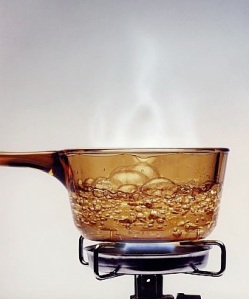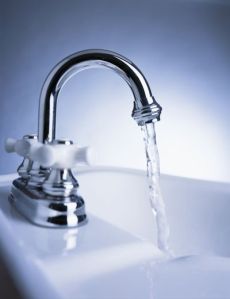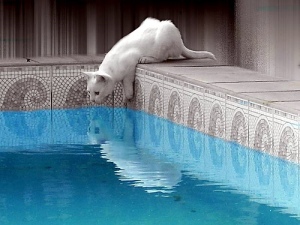By Kellene Bishop
Water Storage Myth: Treat your water and then store it.
Water Storage Fact: Actually, if you use regular tap water, it’s already treated. There’s no need to add any additional chemicals to it when it’s just going to be sitting in a container. If your water needs treatment, do so at the point of using it, not prior to storing it.
Water Storage Myth: Don’t store your water barrels on cement.
Water Storage Fact: Actually, there’s always a missing component to this myth. The key is not to store your water barrels on HEATED cement, and even that’s questionable advice. To store your water in your basement on the cement floor is just fine. There’s no need to make your barrels less st
able by putting them on 2 x 4s. Cement only leaches chemicals when it gets hot. If you’re going to store your water in your garage, where the sun heats up the connecting driveway cement, then yes, I’d consider raising your barrels up on floor boards or such.
Water Storage Myth: Stored water tastes bad.
Water Storage Fact: Stored water is merely lacking oxygen. You can get it back to tasting great simply by pouring it back and forth a couple of times between a couple of pitchers, or glasses. This will infuse oxygen back into your water.
Water Storage Myth: I’ve got a pool out back for our water storage, so I don’t need to store any otherwise.
Water Storage Fact: One who has this opinion is taking a big risk, one which I would not venture to take. It’s presuming that no animal waste, nuclear waste, or other biological poisoning will enter the pool water. Also, if there is a water shortage in your a
rea, and your big pool is out there for all of the desperate folks to see, you’re simply begging for some dangerous self-defense scenarios. You might as well leave your car doors unlocked with your wallet on the front seat. In the event of a real emergency, I would ALWAYS recommend that families store water as well as presuming that their pool water supply will be available, thus preventing it from outdoor contaminates and ensuring that you have water to survive in the event of all possible scenarios.
Water Storage Myth: I have iodine tablets and I know where th
e river is.
Water Storage Fact: You and everybody else. Just how long do you think that river supply is going to be available to you and your family? How useful will that river supply be to you in the event of a flood? Iodine tables don’t do too well with cleaning out home and body parts. How much vital physical energy will it take you to fetch enough water for you and your family to survive long term? People who have this attitude sure are taking a huge gamble. Remember that conserving your own physical energy should be your first priority in an emergency. So purposefully putting yourself in a situation in which you need to work hard for water is short-sighted. Also, you’re assuming that your iodine tablets will take care of whatever is in the outdoor water, regardless of what it’s been exposed to. (See previous myth/fact example) If you have water stored in quality containers in your home, you can save yo
ur physical energy for other more important tasks, and you will ensure that your water supply is protected and is YOURS. Not only that, but chemical treatment of water is not the safest. Heating your water, such as boiling it, is by far the safest method of treating your water.
You’re also assuming that you won’t be quarantined and that the streets will be safe to travel.
 >
>Photo c/o alwaysupward.com
Water Storage Myth: Boil your water for 10 minutes in order for it to be safe.
Water Storage Fact: Actually, you do not need to boil your water. Boiling the water is actually a waste of precious fuel. Water boils at 212 degrees. However, getting your water to a heat of 160 degrees for 30 minutes will
kill all pathogens, and 185 degrees at for only 3 minutes. This is true even at a high altitude. (Note that my preferred way of heating water is in a solar oven. No fuel waste!)
Water Storage Myth: You only need 2 weeks worth of water for your family.
Water Storage Fact: Two weeks is only enough to get you from one point to another. Long-term survival will require a year’s supply of water. The magnitude of a disaster which would create a long-term water shortage, would also require 3.5 years of repairs in order for you to have the kind of water access you are accustomed to now. So really, a one year supply of water is still a minimalistic “get-us-through-until-we-can-find-a-good-well-or-other-water-supply”
kind of storage. And besides, if you’re not storing a year’s supply of water, no one else is. So now let’s compound your problem exponentially in your community and discover just how fast the “native get restless.”
Water Storage Myth: I don’t need to drink a gallon of water a day!
Water Storage Fact: The recommend amount of one gallon per person, per day is not just for drinking. It’s for bathing, (as hygiene is critical), sanitation (you gotta manually flush your stuff in an emergency, folks), medical (some instances require more drinking water than others), cooking, and cleaning. Next time you think one gallon of water a day sounds like a lot, measure how much water you put in the pot when you boil water, wash your dishes, or wash your clothes. It’s a LOT more than you think!
Also, your kidneys process the equivalent of 400-500 gallons of water per DAY! If you don’t feed your body new water, then the old water ends up looking like nasty oil in a car that hasn’t been changed in 10,000 miles. When times are tough, you don’t want t
o try and use that kidney of yours as a commercial slime filter, do you?
Water Storage Myth: Food is more important than water.
Water Storage Fact: Nope. You can go several days without food. You cannot live without water for longer than ONE day without seriously beginning to tax your body. It only goes downhill from there. Without water, your muscles lose their elasticity, your organs shut down, and your senses are dulled. None of these are situations you want to occur during an emergency.
Water Storage Myth: I don’t need water. I’ve got a year’s supply of Gatorade.
Water Storage Fact: Liquid intake is not the same as water intake. The moment you add ANYTHING to your water, your body no longer takes it in as water. It has to process it, filter it, and THEN use what water is left in the liquid before it benefits from it. If your body has to work hard to process the liquids it takes in, it’s using more vital energy. In a perfect world, your water drink for refreshment would consist of distilled water, as that’s what you body can use the most readily.

Water Storage Myth: I’ve got 2-liter bottles, old milk jugs, and juice bottles full of water. I’m set.
Water Storage Fact: Ok. This is better than nothing. But if it’s water than you intend on saving your life, I would definitely consider more sturdy and durable containers. In my opinion, even the water that is sold in the stores is insufficiently packaged for long-term storage in most cases. The plastic is too vulnerable for rugged use and access. I also don’t advise storing drinking water in used containers. And whatever you do, stop storing water in the old milk jugs. Those are the WORST in terms of chemical leaking and plastic breakdown.
Water Storage Myth: I’ve got ten 55 gallon drums full of water. I’m set.
Water Storage Fact: It’s great that you’ve got that much water. However, consider also having some water that’s more portable as well. It will make your life physically easier in surviving a long-term emergency situation. And by all means, make sure you’ve got the hardware necessary to get your water out of those big drums such as a hand pump, wrench, etc.
Copyright 2009 Kellene Bishop. All rights reserved. You are welcome to repost this information so long as it is credited to Kellene Bishop.

